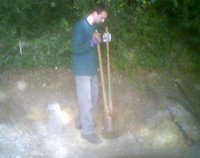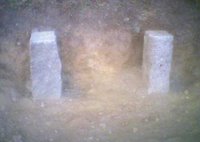A Tale of Two Granites...
 Two Fridays ago I was assigned to install the granite supports for a new bench by a path overlooking the lake on the estate.
Two Fridays ago I was assigned to install the granite supports for a new bench by a path overlooking the lake on the estate.Post holes were dug painstakingly in the stoney soil with iron digging bars. Shale and sandstone made hard work of just 2ft. Removal of rubble was made easier by a shove-holer.

Hardly the Collossi of Memnon; but fit for purpose and ready for the sweet chestnut seat. Each post was lowered into place using rope and checked with a level for horizontal and vertical alignment. A plank was placed against the face of the first post to help with the alignment of the second. Soil and rubble was packed down around the posts using the digging bar to hold them in place.
 A brief siesta on the lakeshore was a good time to reflect on the week's work.
A brief siesta on the lakeshore was a good time to reflect on the week's work.Granite is a traditional building material you will find used throughout the county for houses, flooring, worktops, Cornish hedges, walls, gate posts, gravestones, monuments and other ancillary structures.
Granite is a widely occuring medium to course grained igneous rock which is nearly always massive, hard and tough, and for this reason it has gained widespread use as a construction stone. Outcrops of granite tend to form tors, rounded massifs, and terrains of rounded boulders cropping out of flat, sandy soils.
Cornish granite - sourced from quarries like those in Bodmin and Longdowns near Falmouth - is softer than Scottish granite or Cumbrian shap granite. The upland spine of Cornwall consists of a series of granite intrusions. From east to west, and with descending altitude, these are Bodmin Moor, the area north of St Austell, the area around Camborne, and the Penwith or Land's End peninsula. These intrusions are the central part of the granite outcrops of south-west England, which include Dartmoor to the east in Devon and the Isles of Scilly to the west, the latter now being partially submerged.

A drawback of living in an area with granite bedrock can be the possible presence of radon. Radon is a natural radioactive gas found in the earth. You can't see or smell it, and outdoors it rarely accumulates to significant levels. But when levels do build up, especially inside buildings, it can cause health problems. Studies in the US and UK suggest that indoor radon exposure is the second leading cause of lung cancer deaths after smoking. Radon in the water supply has been linked to intestinal cancers.
Radon is released when uranium radioactively decays into lead. It moves through cracks and fissures within the subsoil into the atmosphere or spaces under and in dwellings. Soils containing high levels of uranium include granite, which explains why Cornwall is often affected. But uranium also occurs Derbyshire limestone, Northamptonshire ironstone and in the red sanstone of Somerset.
The Building Research Establishment website contains some comprehensive advice regarding the hazards, and precautions associated with a radon risk. The Health Protection Agency is also an excellent resource for all that house buyers or home owners might need to know about radon risks.


0 Comments:
Post a Comment
<< Home